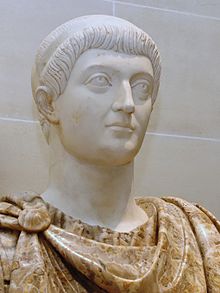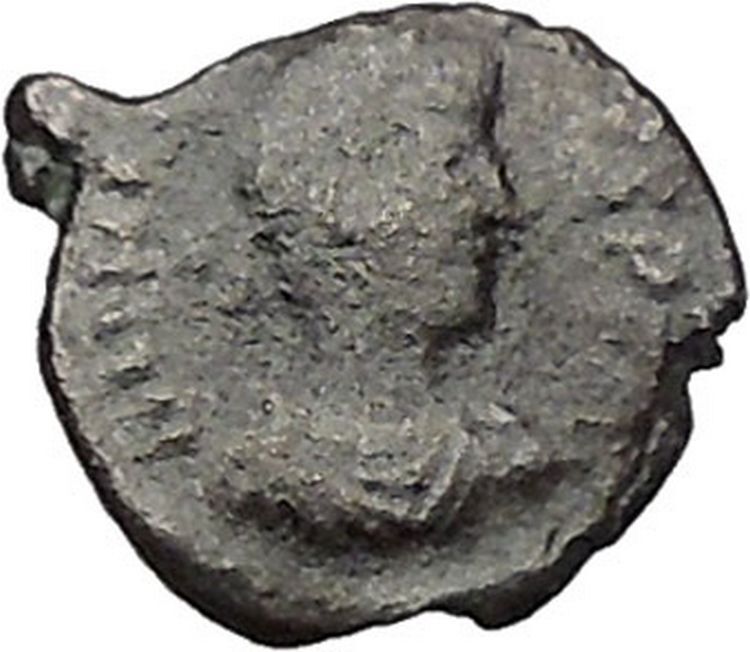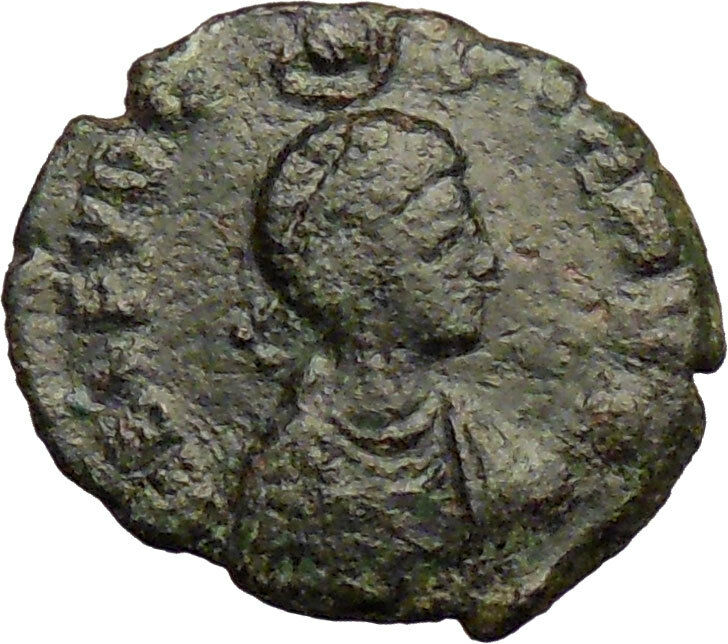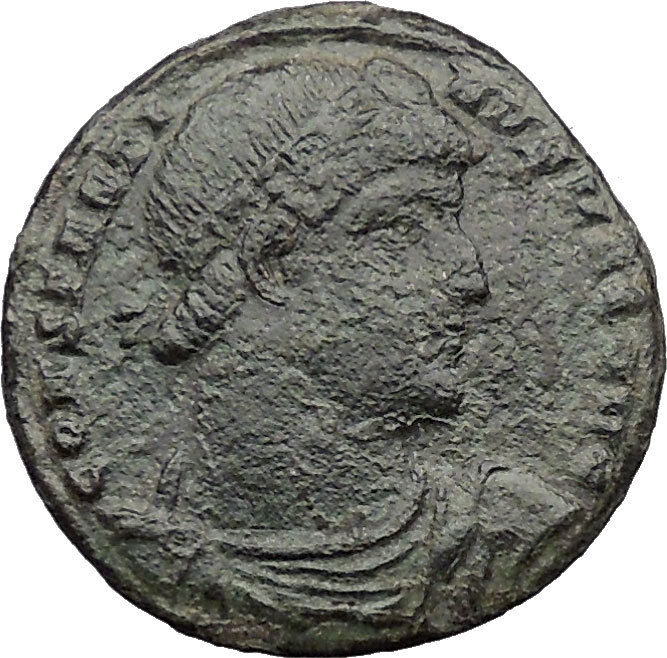|
Anonymous Issue – Rome City Commemorative
Bronze AE3 14mm (2.30 grams) Rome mint, struck circa 348 A.D
Reference: RIC VIIII 104; LRBC 611; Sear (1988) 3896 (VERY RARE R4)
ROMA, helmeted bust of Roma right, wearing imperial mantle.
P-R across fields, emperor, helmeted and in military dress, standing left, looking right, holding spear in right hand and resting left hand on shield.
This rare type is a commemorative along the lines of the Constantinople commemoratives of the previous decade. They were issued jointly under Constans and Constantius II.
You are bidding on the exact item pictured, provided with a Certificate of Authenticity and Lifetime Guarantee of Authenticity.

In ancient Roman religionn, Roma was a female deity who personified the city of Rome and more broadly, the Roman state. “As personification, as goddess or as symbol, the name Roma stretches from classical Greece to Mussolini’s Fascist propaganda… Roma has been seen as a goddess, a whore, a near-saint, and as the symbol of civilization itself. She remains the oldest continuous political-religious symbol in Western civilization.” Ronald Mellor, Introduction, The goddess Roma.
The earliest certain cult to dea Roma was established at Smyrna in 195 BCE, probably to mark Rome’s successful alliance against Antiochus III. Mellor has proposed her cult as a form of religio-political diplomacy which adjusted traditional Graeco-Eastern monarchic honours to Republican mores: honours addressed to the divine personification of the Roman state acknowledged the authority of its offices, Republic and city as divine and eternal.
Democratic city-states such as Athens and Rhodes accepted Roma as analogous to their traditional cult personifications of the demos (ordinary people). In 189 BCE, Delphi and Lycia instituted festivals in her honour. Roma as “divine sponsor” of athletics and pan-Hellenic culture seems to have dovetailed neatly into a well-established and enthusiastic festival circuit, and temples to her were outnumbered by her civic statues and dedications. In 133 BCE Attalus III bequeathed the people and territories of Pergamon to Rome, as to a trusted ally and protector. The Pergamene bequest became the new Roman province of Asia, and Roma’s cult spread rapidly within it.
In Hellenistic religious tradition, gods were served by priests and goddesses by priestesses but Roma’s priesthood was male, perhaps in acknowledgment of the virility of Rome’s military power. Priesthood of the Roma cult was competed among the highest ranking local elites. In contrast to her putative “Amazonian” Roman original, Greek coinage depicts Roma in the “dignified and rather severe style” of a Greek goddess, often wearing a mural crown, or sometimes a Phrygian helmet. She is occasionally bareheaded. In this and later periods, she was often associated with Zeus (as guardian of oaths) and Fides (the personification of mutual trust). Her Eastern cult appealed for Rome’s loyalty and protection – there is no reason to suppose this as other than genuine (and diplomatically sound) respect. A panegyric to her survives, in five Sapphic stanzas attributed to Melinno. In Republican Rome and its Eastern colonae her cult was virtually non-existent.
Roma was thus absorbed into the earliest (Eastern) form of “Imperial cult” – or, from an Eastern viewpoint, the cult to Augustus was grafted onto their time-honoured cult to Roma. From here on, she increasingly took the attributes of an Imperial or divine consort to the Imperial divus, but some Greek coin types show her as a seated or enthroned authority, and the Imperial divus standing upright as her supplicant or servant.The Imperial cult arose as a pragmatic and ingenious response to an Eastern initiative. It blended and “renewed” ancient elements of traditional religions and Republican government to create a common cultural framework for the unification of Empire as a Principate. In the West, this was a novelty, as the Gauls, Germans and Celts had no native precedent for ruler cult or a Roman-style administration.
The foundation of the Imperial cult centre at Lugdunum introduced Roman models for provincial and municipal assemblies and government, a Romanised lifestyle, and an opportunity for local elites to enjoy the advantages of citizenship through election to Imperial cult priesthood, with an ara (altar) was dedicated to Roma and Augustus. Thereafter, Roma is well attested by inscriptions and coinage throughout the Western provinces. Literary sources have little to say about her, but this may reflect her ubiquity rather than neglect: in the early Augustan era, she may have been honoured above her living Imperial consort.
In the city of Rome itself, the earliest known state cult to dea Roma was combined with cult to Venus at the Hadrianic Temple of Venus and Roma. This was the largest temple in the city, probably dedicated to inaugurate the reformed festival of Parilia, which was known thereafter as the Romaea after the Eastern festival in Roma’s honour. The temple contained the seated, Hellenised image of dea Roma – the Palladium in her right hand symbolised Rome’s eternity. In Rome, this was a novel realisation. Greek interpretations of Roma as a dignified deity had transformed her from a symbol of military dominance to one of Imperial protection and gravitas.
 Constans (Latin: Flavius Iulius Constans Augustus; c. 323 – 350) or Constans I was Roman Emperor from 337 to 350. He defeated his brother Constantine II in 340, but anger in the army over his personal life (homosexuality) and favouritism towards his barbarian bodyguards led the general Magnentius to rebel, resulting in the assassination of Constans in 350. Constans (Latin: Flavius Iulius Constans Augustus; c. 323 – 350) or Constans I was Roman Emperor from 337 to 350. He defeated his brother Constantine II in 340, but anger in the army over his personal life (homosexuality) and favouritism towards his barbarian bodyguards led the general Magnentius to rebel, resulting in the assassination of Constans in 350.
Constans was the third and youngest son of Constantine the Great and Fausta, his father’s second wife. He was educated at the court of his father at Constantinople under the tutelage of the poet Aemilius Magnus Arborius.
On 25 December 333, Constantine I elevated Constans to the rank of Caesar at Constantinople. Constans became engaged to Olympias, the daughter of the Praetorian Prefect Ablabius, but the marriage never came to pass. With Constantine’s death in 337, Constans and his two brothers, Constantine II and Constantius II, divided the Roman world between themselves and disposed of virtually all relatives who could possibly have a claim to the throne. The army proclaimed them Augusti on September 9, 337. Almost immediately, Constans was required to deal with a Sarmatian invasion in late 337, over whom he won a resounding victory.
Constans was initially under the guardianship of Constantine II. The original settlement assigned Constans the praetorian prefecturess of Italy and Africa. Constans was unhappy with this division, so the brothers met at Viminacium in 338 to revise the boundaries. Constans managed to extract the prefecture of Illyricum and the diocese of Thrace, provinces that were originally to be ruled by his cousin Dalmatius, as per Constantine I’s proposed division after his death. Constantine II soon complained that he had not received the amount of territory that was his due as the eldest son.
Annoyed that Constans had received Thrace and Macedoniaa> after the death of Dalmatius, Constantine demanded that Constans hand over the African provinces, which he agreed to do in order to maintain a fragile peace. Soon, however, they began quarreling over which parts of the African provinces belonged to Carthage, and thus Constantine, and which belonged to Italy, and therefore Constans. This led to growing tensions between the two brothers, which were only heightened by Constans finally coming of age and Constantine refusing to give up his guardianship. In 340 Constantine II invaded Italy. Constans, at that time in Dacia, detached and sent a select and disciplined body of his Illyrian troops, stating that he would follow them in person with the remainder of his forces. Constantine was eventually trapped at Aquileia, where he died, leaving Constans to inherit all of his brother’s former territories – Hispania, Britannia and Gaul.
Constans began his reign in an energetic fashion. In 341-42, he led a successful campaign against the Franks, and in the early months of 343 he visited Britain. The source for this visit, Julius Firmicus Maternus, does not provide a reason, but the quick movement and the danger involved in crossing the channel in the dangerous winter months suggests it was in response to a military emergency, possibly to repel the Picts and Scots.
Regarding religion, Constans was tolerant of Judaism and promulgated an edict banning pagan sacrifices in 341. He suppressed Donatism in Africa and supported Nicene orthodoxy against Arianism, which was championed by his brother Constantius. Although Constans called the Council of Sardica in 343 to settle the conflict, it was a complete failure, and by 346 the two emperors were on the point of open warfare over the dispute. The conflict was only resolved by an interim agreement which allowed each emperor to support their preferred clergy within their own spheres of influence.
Constantius II – Roman Emperor: 337-361 A.D. | Caesar, 324-337 A.D.
Son of Constantine the Great and Fausta | Brother of Constantine II, Constans, Constantina (wife of Hanniballianus and Constantius Gallus) and Helena the Younger (wife of Julian II) | Half-brother of Crispus | Half-cousin of Delmatius, Hanniballianus, Constantius Gallus, Julian II, Licinius II and Nepotian | Grandson of Constantius I ‘Chlorus’, Helena, Maximian and Eutropia | Father of Constantia (wife of Gratian) |
.jpg/250px-Bust_of_Constantius_II_(Mary_Harrsch).jpg) Flavius Iulius Constantius, known in English as Constantius II (7 August 317 – November 3 361) was a Roman Emperor (337-361) of the Constantinian dynasty. Flavius Iulius Constantius, known in English as Constantius II (7 August 317 – November 3 361) was a Roman Emperor (337-361) of the Constantinian dynasty.
Constantius joins the lengthy list of emperors whose career was marked by a seemingly endless series of wars both domestic and foreign. He served as Caesar from 324 until his father’s death in 337 at which time he shared the title of Augustus with two other brothers, Constantine II and Constans. To make sure no more Johnny-come-latelies in his family would try their hand at being emperor too it is thought that he engineered a bloodbath that left nary a relative. Constantine II died in battle and Constans was murdered by the men of Magnentius, the first of several usurpers. This left Constantius finally as sole legitimate emperor and he moved quickly to suppress Magnentius, an endeavor he eventually accomplished. The strife didn’t end there, however, as he still had to deal with other revolts and wars on every corner of the empire. Caught in these never-ending battles he died while on his way to battle Julian II.
Flavius Iulius Constantius was born at Sirmium (now Sremska Mitrovica in Serbia) in province of Pannonia, the third son of Constantine the Great, and second by his second wife Fausta, the daughter of Maximian. Constantius was made Caesar by his father on 13 November 324.
When the elder Constantine died at Constantinople on 22 May 337, Constantius was nearest of his sons to that city, and despite being on campaign in the eastern provinces, immediately returned to the city to oversee his father’s funeral.
|






 Constans (Latin: Flavius Iulius Constans Augustus; c. 323 – 350) or Constans I was Roman Emperor from 337 to 350. He defeated his brother Constantine II in 340, but anger in the army over his personal life (homosexuality) and favouritism towards his barbarian bodyguards led the general Magnentius to rebel, resulting in the assassination of Constans in 350.
Constans (Latin: Flavius Iulius Constans Augustus; c. 323 – 350) or Constans I was Roman Emperor from 337 to 350. He defeated his brother Constantine II in 340, but anger in the army over his personal life (homosexuality) and favouritism towards his barbarian bodyguards led the general Magnentius to rebel, resulting in the assassination of Constans in 350..jpg/250px-Bust_of_Constantius_II_(Mary_Harrsch).jpg) Flavius Iulius Constantius, known in English as Constantius II (7 August 317 – November 3 361) was a Roman Emperor (337-361) of the Constantinian dynasty.
Flavius Iulius Constantius, known in English as Constantius II (7 August 317 – November 3 361) was a Roman Emperor (337-361) of the Constantinian dynasty.




